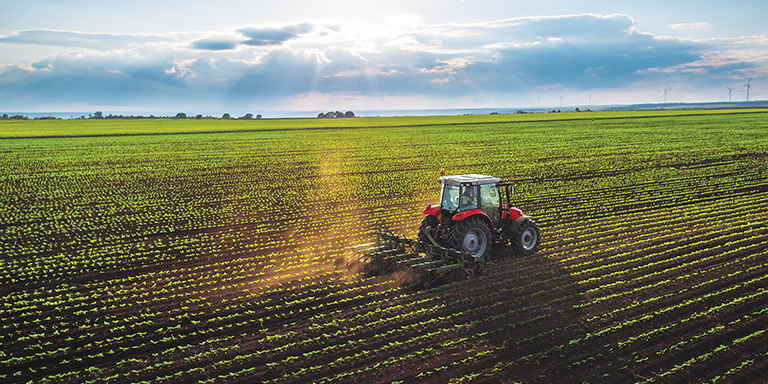A First-of-its-Kind Guide for Iowa Farm Vehicles
“Plowing Through the Regulations: A Farmer’s Guide to Iowa Transportation” has been a huge success.
Iowa is a big farm state, says Angela Pinegar, MBA, director of learning and development, Iowa Department of Transportation (DOT) Motor Vehicle Division (MVD).
“Big” is something of an understatement. Iowa has about 86,800 farms and 30 million acres of farmland, accounting for over 85% of the state’s land. Iowa is also the nation’s leading producer of corn, eggs and pork.
That’s a lot of farming—which requires a lot of farm vehicles. Every year, Iowa DOT’s MVD registers almost 40,000 farm-related vehicles, according to Pinegar.
But the transportation regulations and requirements for all those vehicles are complex and, for many years, had been difficult to access. Farmers had to learn the regulations by hunting for them online or through word of mouth, leading to potential knowledge gaps and misinformation.
In early 2024, under the leadership of Melissa Gillett, then the Iowa MVD director and now the current Iowa DOT COO, the Iowa MVD set out to produce a clear, easy-to-follow guide for farm vehicle regulations. The guide would address a broad range of topics—including covered farm vehicles and exemptions, size and weight regulations, safety regulations, operating rules, commercial driver’s license requirements, and oversize and overweight permits. And it would be the state’s first guide of its kind.
Lay of the Land
To start, the Iowa MVD team had to determine what the state’s farmers knew—and what they needed to know. The team conducted a needs assessment that included a survey of farmers and a review of common online inquiries related to farming regulations.
The team also met with a wide range of agricultural organizations and stakeholders that interact with farmers, including the Iowa Farm Bureau Federation, Iowa Corn Growers Association, Iowa Soybean Association, NEW Cooperative, Iowa State University, county treasurers across the state who serve farmers, and numerous others. The Iowa MVD team identified the transportation-related questions that these organizations commonly encounter and how they were educating farmers about transportation so that the guide would complement that education.
In addition, the team met with the Iowa Department of Public Safety’s Commercial Motor Vehicle Unit to identify the kinds of issues law enforcement often saw when officers interacted with operators during traffic stops.
Armed with this wealth of input, the team decided to organize the guide into four main sections—starting with Iowa’s definition of farm vehicles, followed by the state’s requirements for permitting, licensing and registering.
The Iowa MVD team carefully considered not just the guide’s content but its format as well. The team included graphic tables that break down the many regulations and details into easily digestible chunks. One table, for instance, lists the permitting requirements for hauling various items depending on the type of vehicle and where it’s going. The team also chose to publish the guide as a 3.5-inch by 5-inch book with spiral binding so that it could fit easily into a farmer’s pocket, overalls or glove box.
The Guide Debuts
In August 2024, the guide’s soft launch debuted at the Iowa State Fair, where the team presented it to farmers and solicited their input. “We got a lot of really good feedback from our intended audience,” Pinegar says.
While gathering feedback, Pinegar and her colleagues continually had to determine whether each piece of information they obtained was essential for the guide while ensuring it remained readable. For example, should the guide include specific regulations about transporting raw milk? “We went back and forth on whether that was helpful,” Pinegar says.
That question was answered when the Iowa MVD team released the publication, “Plowing Through the Regulations: A Farmer’s Guide to Iowa Transportation,” at Iowa Ag Expo in February 2025. At the Expo, Pinegar recalls, “a farmer asked, ‘What about raw milk?’ And we said, ‘Yes, we have an answer for that.’ That was very validating,” she says. “All the other questions we were asked were also covered in the guide, and that was a good feeling.”
Iowa DOT plans to promote and distribute the guide during the spring planting and fall harvesting seasons, as well as the annual Iowa State Fair.
A Welcome Reception
Still, Pinegar says, there’s much more information about farm transportation than the guide could include. So, Iowa MVD has been creating an interactive online tool that will go live in July. Users will be able to enter info—such as who is driving, what vehicle they are driving, where they are driving and what they are hauling—and the tool will provide clarification on any registration, licensing and permitting requirements.
Meanwhile, the guide, available in print and as a PDF, has been a welcome asset for the farming community. Since its publication, farmers and farmer associations have been praising the guide and asking for more copies. After the initial print of 5,000 copies, Pinegar had to order another 5,000 just a month later. “I can’t keep up with the printing production,” she says.




